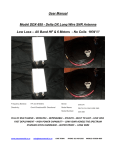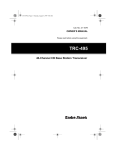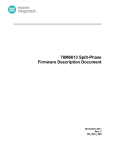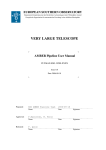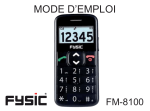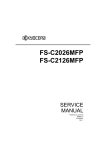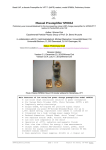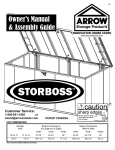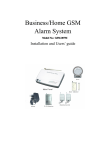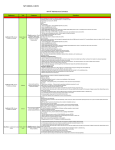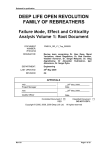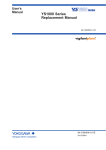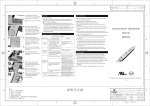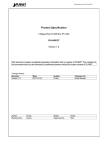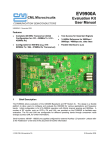Download SHENGDA - imgfunnel
Transcript
SHENGDA SHENGDA COMMUNICATION 144/430MHz Dual band Omni Antenna SDBF1.2E Electrical specifications Frequency Range(MHz) Bandwidtb(ME3z) Polarization 144/430 10 Vertical Impedance 50 Ohm Gain (dBi) Radiation Horizontal Beam Width Vertical Beam Width VSWR Maximum input power (W) Lighting Protection 3. 0/6.0 Omni 360° 57° <1.5 100 Direct Ground Mechanical specifications Connector Connector position Length Packing weight (kg) S 0-239 or customization Radiating Material Radome Material Color Cu Operating temperature ( G ) Material of Hardware-supplied Mounting hardware (mm) Bottom 1200±20 mm 1.2 Fiberglass White -50-70 Metals 031.5mm High Performance Omni Antenna Model: X30 l. 2. 3. 4. 5. d. 7. 8. 10. 11. 12. 13. Frequency: 1+4/430 AIHz Gam (dBi) : 3.0/5.5 dBi VSVVR: less than 1.5 SHENGDA . Polarization: Vertical Maximum input power (W): 150 Lighting Protection Direct Ground 2x5/8wave (430/MElz) Type:1'2wave (1++MHz) Length: 1.3m Connector: MJ Material : Copper, Fiberglass Rated wind velocity: dOm/sec Mast diameter accepted: 03O~0d2 mm r M V\V1 f h To \\ MERCURY MARK II1 Mobile 6 to 80 meter HF ADteona B 3.5-50MHz HF Antenna Electrical specifications Frequency Range(MHz) 3.5-50MHz Impedance(ohm) 50 Gain (dBt) 3. 5 Polarization Vertical Radiation Omni VSWR<1.5 Maximum input power (W) 150 Mechanical specifications Connector UHF-Male(or according customer) Height 1300mm Material Cupper,Stainless steel Color Black Weight 0.3Kg Operating temperature (tl! ) -40 SO includes triple Mobile Mag-motm - 1 Nagoya Mode] No.:77GR Mobile Dual Band Antenna Frequency Range: 144MHzf430MHz VSWR: lass titan 1.5 Gain: 3.5dBi(144MHz}fl»j5d Bi(430M Hz) Polarization: Vertical Wax. Power I r put-watta: 50 W Connector: UHF Height: SBO mm Weight:0.2KG m $ Jj Nagoya Model No.:770S Dual Band Mobile Antenna Frequency Range: 144MHz/430MHz VSWR: less than 1.5 Gain: 2.5dBi(1 44MHz)/3.5dBi(430MHz) Polarization: Vertical Max. Power Input-watts: 50 W Connector: UHF Height: 500 mm Weight:0.15KG t V Strong IS cm Large Mobile Magnetic Mount with RG 58 and PL 259 connector. For the Nagoya 770R and the Nagoya 770s Mobile antennas. Mobile light weight dual Band VHF/UHF antenna whip with own mag mount. 2 Meters /70 cms m \i it' s I m.. Dual Band Rubber Duck i Super Booster Antenna for Hand-Held with SMA fitting. For that extra boosted signal. SHENGDA Model No: RH771 Frequency Range: 144/430MHZ Impedance: SO Ohm VSWR: Less thanl.5 Gain: 3.5 dBi Polarization: Vertical Radiation: Omni Maximum Power Input-watts: 50 W Connector: BNC/SMA-Male/SMA-Female/MX/TNC Radome Material: TPEE Radome Color: Black Weight:0.05KG L, J “ 1 h S / / / . v I / r / / SDY1 4 ft / BAND VHF/UHF YAOt > ShengDa 2 m/70 cm 2m 9.5dBi/70cm Gain: 11.15dBi VSWR: 1 5: 1 or less Max Power: 100 watts FM Boom Length: "130mm 1.2Kg Weight: Connector: N Female Rated Wind Velocity: GO m/s Model DDX-858 - Delta DX Long Wire Snr Antenna Low Loss & Low SWR across all HF Bands from 160 to 6 Meters Revolutionary - No Traps - No Coils - No plugs to change - QRP to 1KW !!! Frequency Band(s): HF and 6 Meters Brand: Directivity: Omni-Directional/BiDirectional Model Name: DELTA DX LONG WIRE SNR Model Number:: DDX-858 Delta DX THE ALL NEW:- Model DDX-858 - 'Delta DX Long Wire SNR' Antenna System Portable & Base Antenna for Amateur and Commercial Radio Operation Low Loss – TX and RX on all HF Bands & 6 Meters - from 1.8 to 54 MHz Stealth and No inconvenient coils, jumpers or plugs to change Handles QRP to 1 KW 60 Foot Long Wire with built-in matching system - Simple to install and Deploys in 5 Minutes This antenna system offers a low SWR across all Bands without an antenna tuner, or with an antenna tuner, an even lower SWR across the bands. It delivers efficiency, does not utilize a lossy 9:1 Balun/Unun system and offers Low Loss across all bands, when deployed correctly and as described in the user guide supplied. The system has it's own built in matching system and no sensitive moving parts. Can be used as a Sloping Wire with the long wire sloping upwards from the matching unit, making it Bi-Directional or as an inverted L, using the long wire, which makes it omni-directional. For the more adventurous, enjoy experimenting with other configurations. A simple to install, high quality, antenna, made of the highest quality materials, all hardware fittings made of Marine Grade Stainless Steel. Long Wire Element is highly durable and UV Resistant, with a porcelain end connector (Porcelain connector shapes may differ from picture). Offers the best Value for money. When considering the price of this, please keep in mind what this antenna is capable of i.e:Handles up to 1 Kilowatt - Low Loss and Low SWR from 160 thru 6 meters 5 Minute deployment - base and portable. - No coils, jumpers or plugs to change, no sensitive moving parts - Stealth !!! Includes: 1 X Delta DX Matching Unit 1 X 60 FT Wire Element Marine Grade Stainless Steel Hardware The ‘Delta DX Vertical Gold’ 80 to 6 meter Multi-Band HF Vertical Antenna system And the ‘Delta DX Rotatable Dipole Gold’ 40 t0 6 Meter Multiband HF Rotatable dipole System. No lossy traps nor coils and QRP to 1KW !!! Comes with the latest matching unit technology, Vertical Mil Whip or Dipole Mil Whips, aluminum mounting bracket, Solid two Meter High Tripod and Superior Quality Carry bag. Hardware of marine grade stainless steel and high quality chrome plated brass Two Great options The ‘Delta DX Vertical Gold’ 80 to 6 meter Multi-Band HF Vertical Antenna system And the ‘Delta DX Rotatable Dipole Gold’ 40 t0 6 Meter Multiband HF Rotatable dipole System. Base & Portable Antenna QRP to 1KW !!! Low Loss, High performance !!! Marine Grade Stainless Steel Hardware ! Stealth - Simple to install and Deploys in 15 Minutes A simple to install, high quality, antenna, made of the highest quality materials, all hardware fittings made of Marine Grade Stainless Steel. Includes standard: 1 X Delta DX Matching Unit 1 X Vertical Mil Whip (or 2 X Rotatable Dipole Mil Whips) 1 X Mounting Bracket (Single type for Vertical or double type for rotatable dipole) Marine Grade Stainless Steel and Chrome plated Brass Hardware 1 X High quality, strong, two Meter High Tripod 1 X Superior Quality Carry bag to carry entire antenna system User Manual Model DDX-858 - Delta DX Long Wire SNR Antenna Low Loss – All Band HF & 6 Meters - No Coils 1KW !!! Frequency Band(s): HF and 6 Meters Brand: Delta DX Directivity: Omni-Directional/Bi- Directional Model Name: DELTA DX LONG WIRE SNR Model Number:: DDX-858 FULL HF MULTI-BAND – VERSATILE – DEPENDABLE – STEALTH – BUILT TO LAST – LOW LOSS FAST DEPLOYMENT – HIGH POWER CAPABILITY – LOW VSWR ACROSS THE SPECTRUM STAINLESS STEEL HARDWARE – WATER PROOF – LONG WIRE www.antennaworld.co.za [email protected] CAPE TOWN PHONE: 021 439 2362 MOBILE: 073528 4950 CAUTION FIRST AND FOREMOST NEVER TAKE CHANCES – SAFETY ALWAYS FIRST Always install antennas securely so that there will be no risk of the antenna, mast or hardware, falling and hurting someone on the ground... or worse. Antennas and Power Line Safety! Extract form an article Ref Chuck Kraly, K0XM Power line Safety label. You may have seen this label on a commercial antenna or other products. If you did not take a moment to read it carefully, Notice the word "near". Is your antenna "near" those power lines or could it be when unforeseen things happen? How close is "too close"? How close is "near"? In this article, Chuck Kraly, K0XM attempts to inform you of the EXTREME DANGER posed by installing an antenna, any antenna, to close to power lines. Now don't make the mistake and say that cannot happen with your antenna, it is made from fiberglass or other material which is an insulator!....you may be "dead" wrong! Read on...... Most new hams are excited when they get their license and they want to get on the air as soon as possible. Many of them have not given a thought to the actual installation of an outside ham antenna and the dangers involved other than getting it up as high as they can and having it fall on them. If you don't read any more of this article, then remember just this very simple statement when putting up any ham antenna, "If there is a power line, including the drop line going to your house, over, under or within a thousand feet of the antenna, IT could FALL AND hit your antenna and YOU while you are installing it!. Although the thousand feet is bit of an exaggeration, PLEASE ,PLEASE follow the warnings. ANYWHERE close is too close. The most important thing you can do FIRST, when installing an antenna, is to LOOK before any part of that antenna, tower, mast or antenna support or any part of that antenna "system" ever gets off the ground. This includes the guy wires...what if suddenly one breaks and flies into a power line. You or someone else is in contact with the mast, or tries to stop the guy wire.. bang, your dead! The principle is very easy. Go outside and consider every possible location for your antenna. Then look at each possible location with the DANGER aspect added to it. Where are the nearest power lines? Are you in the open, or are there trees in the area? Look behind the trees or inside the foliage where they might be lurking, just like a rattle snake hiding there waiting to "strike". Many times it's the power lines out in plain site that will get you or one of your helpers or all within its reach! Then, the SECOND thing you need to do is to get another pair of eyes from a helper to do the same thing...LOOK again at ALL possible hiding places for the danger of power lines and remember, it is the power line that you don't see or the one that you are not too concerned about that will terminate your fun. ASSUME THE WORST WILL HAPPEN! Now consider that most guyed antennas like verticals are supported on "something". It may be a metal mast on the ground, a short metal "tower" with legs on the roof, or a wooden pole or other supposed "non-conductive material. Is it conductive to high voltage? Would you bet your life or your help on not knowing for sure? Assume that everything the antenna is mounted on AND EVERY THING it is connected to is conductive. Don't gamble your life on the words, "I think it is nonconductive"!!! Assume that the guy wires are conductive. If one breaks and snaps back or "accidentally" slips out of yours or a helpers hand, which direction will it likely go...toward the power line? If it is under much tension at all, it will act like a whip...Here comes Murphy’s Law.... IT WILL go toward the direction of the power line! Now, assume a domino effect. If your vertical falls toward a small tree that can't take it's weight, the tree will fall, INTO A POWER LINE....the power line connects to the tree, the tree is connected to the antenna or a portion of it, and it is connected to you....that domino effect just bit you like that rattle snake with a LETHAL BITE! In short, assume that the antenna or any portion of it including it's guy wires, feed lines, support, etc. WILL fall or break while you are putting it up "near" power lines. If any power lines are within "striking" distance of ANY portion of the antenna or it guys, support ropes, etc.....you may wish...for a split second, that you had planned your life much better rather than being in a hurry and court disaster. So far, we have talked about vertical type antennas. You should apply the above tips to ANY ham radio antenna, or antenna installation no matter how it is designed, how small or what it is made of. Your antenna is your "friend" but it or any part of it could be your enemy! Plan far ahead with these tips: Let others know what you will be doing and not just the person or persons helping you. All of you may need emergency care and no one may be able to call for it. If you are not sure what you are doing, get expert help! Plan your steps as if your life and those around you depend on it. Notify a family member or neighbor that you will be putting up the antenna. Ask them to keep an eye AND an ear out for you... HAVE EVERYTHING WELL PLANNED. NO ALCOHOL OR DRUGS! WHILE INSTALLING ANTENNAS. Get a good night’s rest before the big day. Have a clear mind when you are installing antennas. Have more than enough help. Make sure all those involved with the installation know exactly what will be done and in the proper steps. Make a plan and let your helpers know ALL of the details... Make sure all concerned know what to do if the antenna or any part of it starts to fall toward a power line.....simple....let go....get as far away as possible from ANY part of the antenna.....let it fall...DO NOT TRY TO KEEP IT FROM FALLING INTO THE POWER LINE.....YOUR EFFORTS COULD BE LETHAL. Do not try to install the antenna in bad weather with wet ground, snow, ice, etc. There is an old ham saying, "Bad weather is the best weather to put up an antenna". Don't believe it. Mother nature loves to disrupt antenna installations and get you hurt or .....worse. NEVER, NEVER, NEVER put up or even think about putting up any kind of antenna when you can hear thunder. If you can hear thunder in the distance, lightning can strike you! some or all of the material above will help at least one of you save your life or others. Pass this information along and get the word out...be safe... and enjoy ham radio. Introduction Thank you for purchasing and using the Model DDX-858 - Delta DX Long Wire Snr HF antenna system. The system comprises of the following: 60 feet of wire Delta Match Isolation loop Stainless steel attachment hardware Porcelain Insulator The Insulator is permanently attached to one end of the Model DDX-858 Antenna Wire Connector Antenna Connection The Antenna Connection is located on the top of the Matcher. It is a 3/8” x 24 (fine thread) female fitting. Counterpoise Connection The Counterpoise Connection is located on the bottom of the Model DDX-858 Matching unit It is a 3/8” x 24 (fine thread) male fitting, with two nuts. Optional counterpoise cables may be fitted and tighten between the two stainless steel nuts. Antenna Shackle The Antenna Shackle assembly, consists of a shackle, bolt, and nut. It is attached to the top of the matching unit. Carabiner The Carabiner is a removable pear-shaped stainless steel hooks with a spring-loaded gate. Antenna Configurations Using the supplied components, the Model DDX-858 can be deployed in various configurations. These are just some of the configurations that this versatile antenna system can be utilized for, more options on request. A. Sloping Wire with the long wire sloping upwards from the matching unit. B. As an inverted L using the Long Wire. C. As a dipole in the field or base, using an optional extra Long Wire Sloping Wire Configuration The Sloping Long Wire configuration, is a broadband short to long range HF antenna. It is designed to provide acceptable ground wave and sky wave propagation. This configuration is predominately omnidirectional, becoming slightly bidirectional towards both ends of the antenna wire as the frequency increases. The Sloping Wire requires one support and should be mounted at a height of 25 to 40 feet for best performance. A counterpoise wire, with a length of 20 to 40 feet, is recommended. If a counterpoise is not used, the coaxial cable must be 25 to 100 feet in length, as the shield of the coaxial cable provides the counterpoise. Site Selection and Preparation. 1. Select a site to deploy the Model DDX-858 Sloping Wire configuration. The site must have a support that will position the end of the Antenna Wire at a height of 25 to 40 feet. If the right support is unavailable, any convenient object, such as a fence post or the top of a vehicle, may be used as a field expedient support with reduced performance, But always follow the safety precautions above. 2. If not already attached, connect a Carabiner to the Wire Connector end of the Antenna Wire. Connect the Matcher. Refer to steps (3) – (7) below. 3. Temporarily remove the Antenna Shackle from the Antenna Connection. 4. Place the Wire Connector from the Antenna Wire over the Antenna Connection and replace the Antenna Shackle. Tighten the nut snugly. 5. Connect the Carabiner from the Antenna Wire to the Antenna Shackle. 6. If using a counterpoise wire, connect it to the Counterpoise Connection . Tighten the nut snugly. 7. Connect coaxial cable the UHF Socket on the matcher. Raise the Antenna. 8. Using a Bowline or similar knot, tie the end of a short length (around 4 feet) of Paracord to the Carabiner from step (5). 9. Drive a Stake into the ground near the location closest to the radio set and tie the Paracord from the Hybrid Base to the Stake using two Half Hitches, or similar knot. 10. Using a Bowline, or similar knot, tie a long length (50 feet or more) of Paracord to the Insulator or Isolation Loop at the end of the Antenna Wire. 11. Using a throw weight or some other method, loop the Paracord over the support. 12. Raise the end of the Antenna Wire to the desired height, such that the Antenna Wire is not quite taut, and secure it to the support using a Round Turn and two Half Hitches, or similar knot. Extend the Counterpoise. 13. If using a counterpoise wire, extend it along the ground in any convenient direction. 14. Perform operational test. 15. This completes deployment of the Sloping Wire configuration. Inverted “L” Configuration The Inverted “L” configuration is a broadband short to long range HF antenna. This configuration tends to be unidirectional, favoring the horizontal end of the antenna. It is also provides effective ground waves communication during the day time on frequencies between 1.8 – 4.0 MHz without using sky wave propagation. The Inverted “L” requires two supports and should be mounted at a height of 25 feet for best performance. Though, it will provide good performance at a height of 10 to 20 feet, and is usable when mounted as low as three feet. One counterpoise wire, with a length of 20 to 40 feet, is recommended. If a counterpoise is not used, the coaxial cable must be 25 to 100 feet in length, as the shield of the coaxial cable provides the counterpoise. Site Selection and Preparation. 1. Select a site to deploy the Inverted “L” configuration. The site must have two supports that will position the corner of the “L” and the end of the Antenna Wire at a height of 25 feet. If the right supports are unavailable, any convenient objects, such as fence posts or the tops of vehicles, may be used as a field expedient supports with reduced performance. 2. If not already attached, connect a Carabiner to the Wire Connector end of the Antenna Wire. Connect the Matcher. Refer to steps (3) – (7) below. 3. Temporarily remove the Antenna Shackle from the Antenna Connection . 4. Place the Wire Connector from the Antenna Wire over the Antenna Connection and replace the Antenna Shackle. Tighten the nut snugly. 5. Connect the Carabiner from the Antenna Wire to the Antenna Shackle. 6. If using a counterpoise wire, connect it to the Counterpoise Connection. Tighten the nut snugly. 7. Connect the coaxial cable or to the UHF Socket on the Matcher. Raise the Antenna. 8. Using a Bowline or similar knot, tie the end of a short length (around 4 feet) of Paracord to the Carabiner from step (5). 9. Drive a Stake into the ground near the location closest to the radio set and tie the Paracord from the Hybrid Base to the Stake using two Half Hitches, or similar knot. 10. Using a Bowline or similar knot, tie a long length (50 feet or more) of Paracord to the Insulator or Isolation Loop at the end of the Antenna Wire. 11. Using a throw weight or some other method, loop the Paracord over the support closest to the radio set. 12. Pull the Paracord and end of the Antenna Wire over the support. 13. Using a throw weight or some other method, loop the Paracord over the other support. 14. Pull the Paracord, such that the Antenna Wire is not quite taut, and secure it to the support using a Round Turn and two Half Hitches, or similar knot. 15. If using a counterpoise wire, extend it along the ground under the antenna. 16. Perform operational test. 17. This completes deployment of the Inverted “L” configuration. Troubleshooting 1. If using the Antenna Wire , ensure Wire Connector is securely connected. 2. Inspect Antenna Wire for breakage or signs of strain. 3. Ensure UHF Plugs are securely tightened. 4. Inspect Coaxial Cable assembly for cuts in insulation or exposed shielding. Replace if damaged. 5. If still not operational, connect a Standing Wave Ratio (SWR) Power Meter and check SWR. 6. If SWR is excessively high, check antenna tuner or coupler using the technical manual or manufacturer’s procedure. Be sure to check the Coaxial Patch Cable that connects the radio set to the antenna tuner or coupler. 7. If still not operational, replace Coaxial Cable assembly. Most problems with antenna systems are caused by the coaxial cables and connectors. 8. Connect a Multi-Meter to the Antenna Wire to check continuity. Replace assemblies that do not pass a continuity check. 9. If still not operational, contact your dealer, who will be able to assist further a quickly get you back on the air. Specifications Frequency: 1.8 – 54 MHz Power: Model DDX-858 - Delta DX Long Wire SNR Antenna: 1000 Watts PEP SSB RF Connection: UHF Plug (PL-259) SWR: Subject to frequency and configuration. Personnel Requirements and Setup Time: Less than 10 minutes. Optional Accessories Counterpoise Kit. The Counterpoise Kit is ideal for portable antenna deployment. The system will create the groundplane needed to any vertical antennas and will also play the role of guy wires. It contains four wire radials secured around plastic wire winders and four steel tent stakes. Recommended non-supplied accessories The following hardware is needed to attach the counterpoise wires to the matcher base. Wide range antenna tuner required on certain bands. Flashlight. Multi-tool. Throwing weight and string. Mallet. SWR Power Meter. Multi-Meter. 50’ Paracord and Line Winder. Counterpoise Wire/s www.antennaworld.co.za [email protected] CAPE TOWN PHONE: 021 439 2362 MOBILE: 073528 4950



































